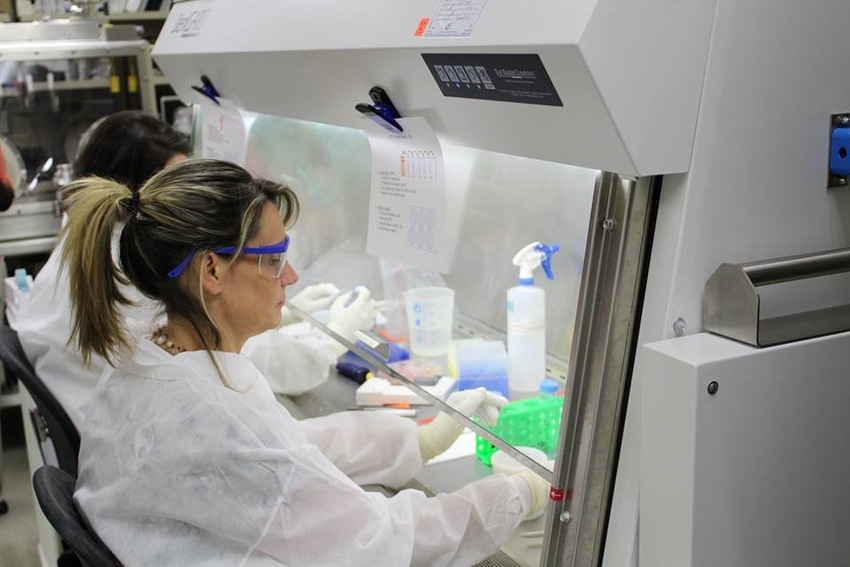Effectively combating TADs requires innovative technical solutions that keep U.S. ahead of the threat.
October 26, 2017

Although the school year is well underway, some students kept busy over the summer by honing their skills through specialized learning opportunities.
The U.S. Department of Homeland Security Science & Technology Directorate (S&T) funded two such programs -- Texas A&M University’s Bench to Shop program and Kansas State University’s Transboundary Animal Disease Fellowship -- to train the next generation of animal health experts.
The National Bio & Agro-defense Facility (NBAF) opens in 2022, and new scientists with this type of training are needed to ensure the ability to adequately carry out the research critical to protecting the health and security of U.S. animal and public health.
Transboundary animal diseases (TADs) are highly contagious, with high morbidity and mortality rates. These diseases quickly cross national borders, negatively affecting a country’s economic stability and public health by reducing exports, food quality and quantity and the availability of livestock products and animal power. They pose serious threats to a country’s well-being, and scientists around the world are continuously investigating new methods to prevent their spread.
“Domestic agriculture is vital to the economic health of the U.S.,” said Michelle Colby, chief of S&T’s Agriculture Defense Branch. “Agricultural products contributed more than 5% to the U.S. gross domestic product in 2015. Any deliberate or natural disruption of the U.S. agricultural enterprise would constitute a serious threat to the national economy and social stability. (TADs) represent a grave threat to the U.S. livestock industry due to their ability to disrupt both the export and domestic commerce of animals and animal products.”
Effectively combating TADs requires innovative, technical solutions that keep the U.S. ahead of the threat. For this reason, the S&T Homeland Security Advanced Research Projects Agency’s Chemical & Biological Defense Division partnered with the two universities to develop training programs for individuals who will develop the next generation of TAD identification, prevention and mitigation capabilities.
The Texas A&M University Bench to Shop Program focuses on developing business management and legal skills to help participants improve their ability to plan, execute, evaluate and transition TAD research and development technology to the marketplace. The course, which starts with online classes and culminates in a three-week-long hands-on training, provides students with insight into four categories of TAD expertise: vaccines, diagnostics, therapeutics and biologically relevant specimens.
“This is a great experience and one opportunity that not many scientists in the U.S. get,” said Dr. Tammi Krecek, research professor at the Texas A&M College of Veterinary Medicine & Biomedical Services.
Students travel to Texas, Colorado and South Africa during the experiential training, where they have several opportunities to work in laboratories, speak with experts and participate in outbreak exercises. This valuable, hands-on experience helps inform future research and development and helps participants understand the full spectrum of TAD threats. During the summer of 2017, Bench to Shop participants learned about developing human and animal vaccines and diagnostics, selecting personal protective equipment for different bio-safety levels, establishing laboratory best practices and collecting blood samples from livestock.
“This unique training program connected me with lifelong mentors and invaluable future collaborators while illuminating multiple career paths that I would not have been exposed to in my current formal education, and I feel incredibly fortunate to have had this opportunity,” said Amanda Korum, one of the Bench to Shop program participants.
Kansas State University’s TAD Fellowship began in August 2016 with five doctor of veterinary medicine, doctorate and post-doctoral fellows and launched a second class of six fellows in August 2017. It is designed to foster TAD research expertise in various bio-safety level environments through classroom and practical training in biosafety, containment, research laboratory, animal handling and regulatory compliance. The goal is to invest in graduate degree-seeking individuals or individuals beginning their postdoctoral career, which will help grow the nation’s TAD research capabilities.
"This program leverages the expertise and resources of the Biosecurity Research Institute and the National Emerging Infectious Diseases Laboratory to train next-generation masters and masters of public health students, doctoral students, doctor of veterinary medicine students and postdoctoral researchers to work in high- and maximum containment environments on TADs," said Dana Vanlandingham, associate professor of virology with the Kansas State diagnostic medicine and pathobiology department.
As a part of the TAD Fellowship program, fellows spend their first year participating in traditional classroom activities as well as practical rotations, the last two years of the fellowship include more hands-on training as participants receive Bio-Safety Level 4 simulator training and apply the program competencies in containment through an independent research project under the guidance of an established researcher in the field of TADs.
Both the Texas A&M and Kansas State programs are vital to building a national workforce that is experienced with TADs and other pathogens, S&T said. The expertise these students gain through their respective programs will provide a strong baseline they can use to jump-start future careers at NBAF, animal health agencies or other research institutions. The skills they gain today will be critical to safeguarding the American economy and public health in the years to come.
For more information about S&T’s work on agricultural defense, visit the Chemical & Biological Defense Division page.
You May Also Like
.png?width=300&auto=webp&quality=80&disable=upscale)
.png?width=300&auto=webp&quality=80&disable=upscale)

